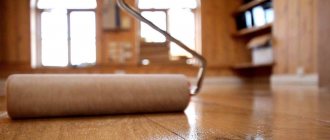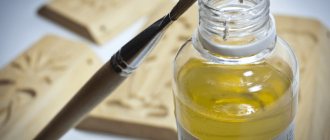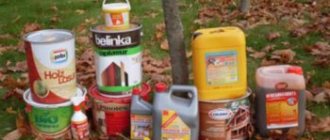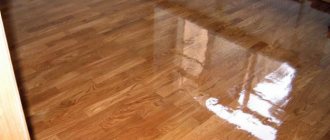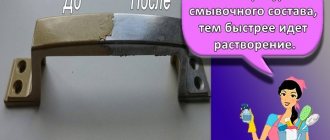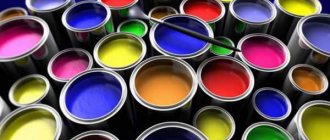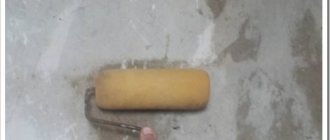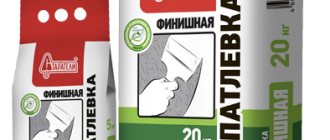Treatment of parquet floors
The floor surface is sanded using different sandpaper.
The sanding agent should not have a fine grained surface, otherwise the dust particles will clog the pores of the wood. After this, the floor surface is puttied, that is, all fasteners and significant defects are covered, and then wax and oil are applied. This is done with a soft brush, the work is done very quickly to avoid clear boundaries between strokes. When the application is complete, polish the wooden object using a special machine or cotton cloth. At the same time, all small scratches and defects become invisible, and the surface acquires gloss and shine. Thus, you can easily restore the old floor covering and it will have a beautiful appearance. When preparing oil wax with your own hands, you must follow the correct technology; after treating the surface with this product, the product takes on an original appearance. Thus, the coating can be given an antique look that suits any interior of the room.
DIY oil application technology
Protective oil for wood at home is prepared according to a recipe: grated beeswax is added to heated pure flax oil. It heats up until a slight smoke appears. The material is ready when the wax melts. Dosing juniper oil in drops will give it a pleasant aroma. The proportions of wax and oil may vary. More often it is 1:1.
First way
The most commonly used option is rubbing flaxseed oil. Fine grain sandpaper (P400) and natural fabric are used. Oil is applied to the fabric, then the surface is polished with it. Large areas can be treated in this way. The procedure is repeated 3-4 times. Each time the coating layer must dry. everything takes about 48 hours.
Second way
The object is immersed in a container of oil. This technique is called soaking. The product remains immersed for 72 hours. After this, the wood is taken out and sanded with a cloth. Oil is used to impregnate wood from flax, sunflower, and hemp.
What does teak oil treatment provide?
Density values for different types of wood
Let us recall that the large number of types of oil impregnations is due to the difficulty of creating a universal composition that would optimally combine the following properties:
- penetrating ability;
- polymerization rate;
- hydrophobicity;
- UV resistance;
- antiseptic effect.
This is due to the fact that different types of wood have different densities, resin contents and, as a consequence, different penetrating abilities.
Teak oil was developed primarily for basic protection of dense wood, although this fact does not exclude the possibility of its use on traditional pine and hardwood building materials.
Since its main area of application is the treatment of external surfaces of log houses, terraces and wooden furniture, it contains additives that increase resistance to sunlight.
- creating reliable and vapor-permeable protection from moisture;
- slow down wood oxidation processes (especially important for teak wood products);
- achieve a beautiful matte color shade;
- extend the service life of wooden products several times.
Note that the basic composition of teak oil does not create a continuous polymer film on the surface of the processed product. That is, after impregnation with this type of oil, products in the vast majority of cases have a matte texture.
But even in this case, there are situations when some manufacturers supplement their series of teak impregnations with compounds containing wax, the treatment of which leads to the creation of a smooth, almost varnished surface.
Where is the best place to apply this finish?
Impregnating wood with linseed oil does not provide a hard protective film that is resistant to scratches and abrasion. But this type of decorative finishing is valued for something else, first of all - environmental friendliness, antiseptic properties, the ability to emphasize the texture of wood and preserve it from cracking.
Flax drying oil is used for finishing products used indoors. It is optimal for covering furniture surfaces that are not subject to intense abrasion, wooden walls and ceilings. It is used to process wooden utensils, cutting boards, and children's toys. As a decorative and protective finish, linseed oil is appropriate to apply to the surface of valuable wood species to maximize the preservation of their natural qualities.
Improved performance
Using linseed oil in its pure form, the question of improving the characteristics of the product invariably arises. There are a variety of folk and professional means for this. Let's look at both in more detail.
Acceleration of polymerization
- turpentine;
- tar;
- wax.
When choosing a means to speed up the reaction, you need to take into account that turpentine is quite toxic, which limits its use only on external surfaces. In addition, it can cause skin burns and allergies, so you need to use protective equipment when working with it.
Tar is the same as turpentine, it is obtained as a result of distillation of wood. It is less toxic, but it is also undesirable to use indoors.
Wax is absolutely harmless and can be used both outside and inside the house. It is one of the best sauna treatments because it does not form a film coating and can also be used for steam room shelves. Wax is used both in pure form and in tandem with linseed oil. To prepare the composition, the wax must first be heated in a water bath.
Cleaning the composition
As has been noted, when exposed to UV rays, linseed oil turns yellow. To prevent the log from yellowing in the sun, the composition is cleaned of impurities before application. The following methods are used for this:
- preparing saline solution;
- adding lead salts;
- mixing with ethanol;
- exposure to light (photo-oxidation).
Color change
Some craftsmen, to tint the oil, use improvised means, for example, spices: turmeric to color it yellow, paprika to give it a red tint, carrots to color it orange. In some cases, oil paints or gouache are added to the oil.
Professional products
Today there are many professional products based on linseed oil, produced under the brands Osmo, Tikkurila, Remmers, Biofa, GNature, Teknos and others. The products of these companies have become widespread and have earned many positive reviews from consumers.
Impregnations include additional components that improve the quality characteristics of linseed oil:
- driers to speed up the polymerization process;
- additives that increase resistance to UV radiation and increase the protective and water-repellent properties of the oil;
- antiseptic additives;
- color pigments.
Manufacturers produce different types of impregnations intended for internal and external processing. You can choose glazing (transparent) or tinting coatings that give the wood the selected shade. A wide palette of colors allows you to choose the product to suit any interior.
In the product line of each manufacturer you can find specialized oil impregnations:
- for covering various elements of the house: floors, ceilings, walls;
- for baths and saunas;
- for processing furniture and countertops;
- for terraces and decking.
Each product has a specially developed composition that allows it to effectively solve the assigned tasks, and its own application technology. Impregnations based on linseed oil have good absorption and low consumption. The service life of coatings obtained using professional impregnations increases to 8-10 years.
What is oil wax and how to make it yourself?
Linseed oil with wax is an effective decorative and protective coating that gives wood high moisture-proof properties and increases its wear resistance. Impregnation adds a silky shine to surfaces and emphasizes the natural qualities of wood. Suitable for processing light and dark wood. A completely natural impregnation is optimal for finishing wooden floors, stairs, doors, furniture and other items subject to intense wear.
It is not difficult to prepare linseed oil and wood wax yourself. The easiest way: add grated beeswax to oil heated in a water bath and bring to a homogeneous consistency. The classic proportion by weight is 1:1. The ratio of wax and linseed oil can be varied, creating compositions of varying degrees of viscosity: from thick mastics to liquid impregnations that penetrate deep into the wood structure.
Selecting oil according to wood type
- Conifers contain resins that prevent oil from penetrating into the structure, so they do not require oil impregnation. To protect the surface, if absolutely necessary, you can use thick compounds in one layer or treat wood of this species by waxing.
- For low-density wood, alder and linden, it is also better to use thick, saturated impregnations. The use of fluid compositions is undesirable, since with deep penetration, they remain inside in a liquid state.
- Beech and birch are characterized by high density, and therefore they are first treated with liquid compounds, and then with thicker ones, which have a high degree of solids, and wax.
Benefits of flaxseed oil
Flaxseed oil is an environmentally friendly product; it protects wood well and has high moisture-repellent properties.
There are a huge variety of stains, varnishes, and chemicals in building materials stores, but they are all toxic and can be harmful to human health. The best way to preserve wooden surfaces is linseed oil. It is considered the strongest waterproofing substance and does not harm the human body. Impregnating wood with this product has a number of advantages:
- environmentally friendly substance;
- helps close even the smallest pores of wood;
- is water-repellent;
- improves the appearance of the wooden surface.
During the impregnation of wood, the substances included in the oil thicken under the influence of external factors (oxygen, light, heat), that is, a polymerization process occurs. As a result of impregnation, linseed oil becomes a semi-solid mass. The more polyunsaturated acid glycerides the oil contains, namely linoleic and linolenic acids, the higher the solidification ability and its protective properties.
After impregnation, the wooden product will need to be allowed to dry so that the wood is protected as much as possible in the future.
Complete drying of the wood surface after treatment with linseed oil will occur in 2-3 weeks.
You can speed up the process using:
The oil thickens as the wood is impregnated and it does not get dirty.
- turpentine;
- wax;
- tar.
When using turpentine, you must remember that this substance is toxic and can cause an allergic reaction. In addition, thermal burns may occur due to direct contact with skin. Tar is a product of dry distillation of wood; it is the same as turpentine, but less toxic. Therefore, to be safe, it is better to choose wax. It is not difficult to dissolve the wax: just heat it in a water bath and mix with oil. This composition has enhanced water-repellent properties.
Which oil is suitable for coating wood?
Author: Anastasia Isakova · Published 05/17/2017 · Updated 04/03/2018
An important role in human everyday life is played by such material as wood. Many people strive, if possible, to have or make wooden furniture with their own hands, as it has a presentable appearance and is environmentally friendly. But, at the same time, wood is a rather capricious material, since it is very easy, without preliminary treatment and protection, to be exposed to moisture and rot. For good and high-quality protection, you can use oil to coat the wood.
There are several types of compositions for these purposes. Protective oil can be purchased at hardware stores or you can make wood impregnation with your own hands.
DIY painting mistakes
Often, unprofessional craftsmen, having received superficial information from the Internet about oil application technology, perform the work themselves. This inevitably leads to errors in work, which affect the quality of painting.
Below are typical mistakes that non-professionals often make:
Violation of technology. Despite the fact that in general the process of applying different types of oil is the same, each impregnation has its own unique composition, which introduces certain nuances into the rules for treating wood with this product. Insufficient surface preparation. Many people do not pay due attention to the preparatory work, do not clean off the old coating well, do poor-quality sanding, and leave uneven spots and cracks. As a result, after applying the oil, all defects come out, which greatly deteriorate the appearance of the coating. Carrying out work at high wood humidity. Humidity is a very important indicator; if you apply oil to undried wood, the impregnation will not be able to penetrate into the deeper layers and provide full protection. Delays or rushed work. Unfortunately, this mistake is often made by contractors.
Compliance with the timing when applying the coating is very important. The first layer must sufficiently saturate the surface before applying the next one. In this case, it is also important to apply a second layer until the surface is covered with dust and dirt.
After all, wood undergoes deep cleaning before painting and should not be left unprotected for a long time. may cause problems with painting technology.
To avoid these and similar mistakes, contact professionals. has more than ten years of experience in finishing and processing wooden houses
Our company pays special attention to quality; all work is carried out under strict control by the technical supervision department
We are official dealers of well-known manufacturers of professional products based on linseed oil Osmo, Remmers, GNature, Biofa, Wooden Wood, Ramsauer, thanks to which we can provide special conditions for our customers. When ordering home treatment with oils from these manufacturers, the cost of the products is calculated at the wholesale price.
Our partner is also the law firm Help Consulting. This is a team of specialists focused on disputes in the construction industry. We always recommend this company to our clients who have fallen into the hands of charlatan builders. If suddenly your choice is not with our company, then before making payments and making advances to the contractor, conduct a legal analysis. This will help save you hundreds of thousands of rubles.
We provide services in Moscow and neighboring regions, to leave your request, contact us using the coordinates on the “Contacts” page.
Calculate the cost of painting and insulating your home right now
Do you have accurate measurements of the house?
I measured it myself. I have a house design. Measurers came. I want to call a measurer.
By clicking on the button, you consent to the processing of personal data
How to insulate an attic or loft yourself
Treatment of wooden surfaces with Biofa oil – protection and preservation of texture
Features of Osmo oil - types and application technologies
Sealant for wood Axton from Leroy Merlin
Preparatory work
To get a beautiful and even coating, you need to go through all the necessary steps and strictly adhere to the application technology. Oil impregnation is absorbed very well into wood, so all the imperfections and defects of the floor will immediately appear under the oil. The surface that is supposed to be impregnated with oil requires more thorough preparation than when varnishing.
Preparing the old floor
- You can use this method: put a sheet of paper on the floor and place a hot iron on it. When exposed to high temperatures, the paint will come off the surface and stick to the paper. The remaining coating is removed with a spatula. You can use special washes, which are available in a wide variety in stores.
- After removing the paint, you need to remove the top layer from the boards using a plane.
- Next, sanding is done with fine-grit sandpaper (150-180).
- All cracks and other defects must be repaired with putty to match the color of the wood.
Preparing the new floor
- Preparatory work for a new floor consists of sanding the surface. This work must be done very carefully, since any defects in the flooring will be visible under the oil.
- Three types of sanding attachments are used for sanding. First, the work is carried out using circles with coarse grain (20), then the base is leveled with a medium-grain nozzle (40). At this stage, you need to putty all the defects, and then perform final polishing with the finest abrasive (150).
- After sanding, the entire floor surface must be thoroughly cleaned of dust using a construction vacuum cleaner. Poor cleaning can also negatively affect the quality of the coating.
All work must be done not manually, but with the help of sanders, and for processing use special pads made of microfiber and felt. The quality of hand grinding is much lower than machine grinding; it is impossible to bring the surface to an ideal state by hand.
Stages of wood impregnation
Linseed oils are used for wood processing in two ways, it all depends on personal preferences and the size of the surfaces being treated:
- Soaking is only suitable for small items (decorative figurines, dishes, etc.);
- Coating (rubbing in).
The following steps will tell you how to treat wood with linseed oil impregnation.
Preparatory stage
Before you start coating wood at home, you must first carefully prepare the surface to be treated. If this is a newly manufactured product, then the surface is simply sanded with high quality using fine sandpaper. Impregnating wooden products with a large area, for example, the facade of a house or previously exposed surfaces, is a little more difficult.
Preparatory work algorithm:
- Get rid of the old coating, that is, varnish or paint. There are several methods you can use here. Try removing the old paint using a spatula and a wire brush. If it doesn’t work, then you need to use a hair dryer.
- Sanding the surface. For this process, sandpaper with varying degrees of abrasive coating is used. You should start with the larger one, gradually reaching the smallest one. The surface is ready if, after running your hand over it, we do not feel any irregularities.
- Remove dust using a soft brush and rag. The key to high-quality oiling with linseed oil for wood is a well-cleaned surface from dust.
Coating process
Oiling of prepared wood can be done using the oiling method. The oil is applied either with an ordinary soft rag or with a brush that has natural bristles. Although painting with a brush is only suitable for small areas. As for the facade of the house, ceilings and other things, you only need to apply oil to the wood with a rag.
Linseed oil for wood is applied according to the following algorithm:
- Pre-stir the composition and pour the required amount into a clean container.
- Moisten a rag and treat the surface with it. It is necessary to apply the composition along the wood fibers.
- After treating the wood with linseed oil, you need to let the surface dry for about 20 minutes, then remove the excess with a clean rag.
- The product soaked in wood coating oil is left to dry for some time, and then the wood is re-coated with linseed oils.
Soaking process
Processing wood by soaking, as mentioned above, is only suitable for small products. The process of soaking wood with oil is quite simple: oil is poured into a clean container, and then the prepared, dust-free product is placed there. You can hold it as long as you like.
Advice! Experts recommend holding the object until not a single bubble remains on its surface.
After the product has been soaked for some time, it is removed and placed on paper in an inclined state. This will allow excess flaxseed oil to drain. When we have got rid of the excess, polish the surface with a clean and soft cloth. Next, leave the product to dry.
If pure linseed oil was used, drying will last three weeks. To speed up drying, use white oil with wax.
The technology for oiling wood with linseed oil is quite simple, but it will reliably protect it from the effects of negative factors. And, if we compare it with various types of industrial compounds, then it is possible to coat wood with oils without harm to human health. Processing wooden products is a process that should not be neglected.
Properties and characteristics of oils
Compound
BIOFA Naturprodukte openly declares the composition of its products and is one of three unique companies in the world that officially report this information. The labels indicate all the components, including:
- cold and hot pressed linseed oil;
- castor oil from castor bean seeds;
- safflower oil from the seeds of Carthamus tinctorius;
- carnauba and North American palm wax;
- tung oil from the seeds of the tung tree;
- rosin;
- driers (drying accelerators);
- beeswax and other natural substances.
All raw materials are pre-tested and comply with the BIOFA standard.
Life time
Since the Biofa oil coating does not peel off or crack, it does not need to be removed after long-term use. The only change that can occur over time is a change in color or loss of shade. This problem can be solved by updating the finishing layer using the same material that was used during the initial processing.
The service life of Biofa paints and oils exceeds those of most other manufacturers and is at least 3-5 years. It is worth considering that the service life of the coating directly depends on compliance with the processing rules.
Drying time
The time required for drying is determined for each product individually and depends both on its composition and on the specifics of application. This figure can vary from 6-8 hours for oil intended for external processing of a log house, and up to 15-20 hours for impregnation of stairs.
The exact drying time depends on temperature, humidity and the availability of fresh air.
Flammability
Although the oils themselves can burn, wood treated with them reduces the flammability rating. Over time, the material, which is located not only on the surface, but also in deep layers, oxidizes and, as a result, does not support combustion.
Consumption
Oil consumption per 1 m2 depends on several factors: the composition used, the condition of the wood, the number of layers applied, the depth of penetration and the time that the log house stood.
Example: Oil 2043 for exterior work when treating a house made of chopped or rounded logs will require consumption of one liter per 18 sq.m. If the coating occurs in two layers, then a liter of the product will be enough for 13 sq.m. If the house is built from glued or profiled timber, a liter of oil will be consumed for 20 (one layer) and 15 (two layers) sq.m. respectively.
At the same time, it is necessary to take into account that, for example, oil-wax is consumed much less, but its task is surface application, and deep penetration oil changes the structure of the wood and makes it much stronger, which extends its service life. Affects the overall consumption and application of primers.
An important point that determines the required volume of material is the experience of the craftsmen performing the processing. If a person has not worked with a specific oil before (as well as paint, varnish, etc.), 10-30% must be added to the consumption in advance.
Palette
The Biofa catalog offers more than 2000 shades; such a diverse palette can satisfy any needs and requirements.
The oil palette consists of 2000 shades
Popular means
Among the oils that are in greatest demand are the following types, each of which is intended for specific work:
- Biofa 2043 is a universal product for outdoor use. It is used to cover wooden facades, terraces, garden furniture, ends of crown logs, and other surfaces exposed to atmospheric loads. Consumption: 20 sq.m./l in one or 15 sq.m./l in two layers. The composition includes antiseptic additives that resist the appearance of mold, mildew and blue stains.
- Biofa 2044 for interior work. It is used when processing ceilings, walls, stairs, floor coverings, doors, and interior elements. Colorless material, the required color is compiled according to the catalog. Consumption 16 sq.m./l per layer, 10 sq.m./l. into two layers.
- Biofa 2049 furniture oil (not used for work surfaces). The surface turns out to be silky, colorless (if you do not tint). Consumption: 40 sq.m./l – one layer, 30 sq.m./l – two layers.
- Biofa 2052 for work surfaces: kitchen furniture, countertops, dishes and toys. Matte silky colorless material with a consumption of 40 sq.m./l for one and 30 sq.m./l for two layers.
- Biofa 8624 – professional oil for floors, stairs, parquet. Creates a semi-gloss colorless surface with coverage of 38 sq.m/l and 26 sq.m/l per one or two coats.
Used oil as protection for wood
People quickly figured out using used motor oil to process wood. It protects the surface of the structure from the negative effects of moisture. It is used to protect warehouses, fences, garages, hangars and other industrial facilities.
Processing wood that has already been damaged protects the structure from subsequent destruction and rotting. Most often they cover the part of the fence that is in contact with the ground. For wood that is already damaged, there is practically no better protective substance to be found.
Among the various compositions used as antiseptics, tar and linseed oils are distinguished. The features of the first type are as follows:
- Strong antiseptic, suitable for insulating the bottom of piers and boats. The surface treated with tar lubricant retains its structure. The substance itself cannot be diluted.
- Easy to apply. The flax base is suitable for household use and impregnation of log buildings.
Linen acts as a strong waterproofing agent. Based on them, a large number of impregnations are produced for the facade and foundation of buildings.
Features of oiling
The best option for protecting wooden products is wood treatment oil. It has many positive characteristics:
- environmental qualities;
- appearance of impregnated products;
- giving the product a matte shine and velvety feel to the touch;
- ease of work;
- low price of the composition;
- the possibility of restoring a damaged surface.
The disadvantages of these protection measures should also be noted:
- very capricious in care, since finishing must be done every 4 months, followed by high-quality polishing of the surface;
- On the treated surfaces, greasy stains are clearly visible, which can be removed by re-processing.
Impregnation with linseed oil is recommended even for expensive wood species.
Useful tips for impregnating wood
All wooden surfaces can be treated with oil. No harmful components are added to it, so you can safely treat even such surfaces as:
Related article: How to make a shower stall in the bathroom with your own hands - expert advice
Apply a thin layer of oil to the wooden surface with a brush.
- wooden spoons, plates;
- children's toys made of wood;
- any furniture;
- ceiling and floor coverings.
The wooden surface should not be wet or damp - this is the main condition for processing. The permissible moisture content in wood should not exceed 14%. If the surface is not new and needs impregnation, first you need to clean it of any remaining varnish or paint. After this, the surface must be cleaned of dust and remaining debris. Under no circumstances should you wipe the wood surface with a wet rag. The wood will immediately absorb moisture. Then clean with sandpaper and remove wood dust. In the room where impregnation will be carried out, the air humidity should not be lower than 70%. If impregnation is carried out outdoors, then not in rainy or foggy weather, but in sunny weather.
You need to apply linseed oil to the wood surface not in a thick, but in a thin layer, and several times. Wooden items that can be used constantly (for example, a floor) need to be treated 3-4 times a year, only in this case it will last a long time. And those household items that are not subject to regular mechanical stress, such as bookshelves or cabinets, need only be treated once every 2-3 years.
Small parts and objects can be immersed in oil for impregnation.
Experts do not recommend impregnating wooden surfaces that are already coated with varnish or paint. There will be no sense from this.
Depending on how curly or smooth the surface is, and also taking into account the thickness of the wood, you need to rely on the amount of oil applied. It is worth noting that a thin layer will harden within a day. If necessary, step-by-step impregnation can be carried out. Treatment can be done 6-8 times.
You can apply linseed oil with foam sponges or a brush. After processing wood, it is better to keep brushes in cold water. The remaining linseed oil must be stored in a cool place, at a temperature not exceeding 0°.
It is an undeniable fact that the wood flooring will be more protected by oil wax. It is made on the basis of linseed oils. In addition, after impregnation of the wood, the color of the surface is preserved and does not change, and due to the fact that the oil wax contains bean wax, the wooden surface becomes shiny. Wax based on linseed oil can be used to impregnate light-colored wood surfaces, including valuable wood species. The following surfaces can be treated with oil wax:
- stairs;
- furniture;
- the inside of the windows;
- interior doors;
- interior wood floors.
Related article: Roof in a private country house: 7 ideas, what and how to make it from (35 photos)
To treat external wooden surfaces, it is better to use pure linseed oil, because only natural and concentrated oil has dirt-repellent properties. Therefore, it is better to treat the external walls of log houses or the walls of a bathhouse with pure linseed oil.
Flaxseed oil is considered a universal and most inexpensive means for preserving wooden coatings. No need to look for expensive water repellents for wood. It is enough to treat the surface and verify the effectiveness. Impregnating wood is a process that takes quite a long time, but the end result will satisfy even the most capricious people.
Impregnation with linseed oil is carried out in two ways:
- rubbing;
- by soaking.
Rub oil into wood only along the grain. For small wood items, soaking is recommended. The item should be completely immersed in linseed oil for several hours or 1-2 days. A prerequisite is that the wood must dry after impregnation.
It is better to coat wooden surfaces with linseed oil rather than varnish. The fact is that the varnish cracks over time, and moisture can get into small cracks, which will lead to swelling of the wood. The wood will begin to deteriorate and swell within a few months. Linseed oil penetrates deep into the wood and does not become glassy after drying. Accordingly, cracks will not occur, and the access of moisture to the wood will be limited. Due to the fact that cracks do not appear, the linen coating retains its shine much longer.
Painting with machine oil
Before the actual procedure, you need to prepare all the required tools and parts. They are as follows:
- Used motor oil. Before direct use, it must be mixed thoroughly. The used composition should not have large impurities or other liquid inclusions.
- Latex gloves. At the time of using the antiseptic in question, exposed skin should be protected.
- Cotton cloth, sandpaper. Wood protection should be carried out after preliminary surface preparation.
- Rollers, brushes, sprayer. There are several ways to apply used oil. Processing wood manually is most often carried out using a roller, since with this tool it is easier to distribute the substance evenly. It is worth considering that the tools used will be unusable in the future.
When using oil as an antiseptic, you need to thoroughly saturate the structure. The whole procedure can be divided into several stages:
- Preparation. After cleaning the oil, you need to clean the surface to be treated from dust and other contaminants. The use of special degreasers will improve the quality of the final result.
- The machine lubricant can be slightly heated, which will speed up the absorption and drying process. It is easier to treat the surface with warm oil due to its increased fluidity.
- If you need to cover a large area, you can use a sprayer or roller. Small parts and elements are impregnated with a brush. During work, debris and other foreign elements must not be allowed to enter.
- It takes several hours or days to dry. Therefore, when treating a facade or foundation, you should wait for dry weather.
It takes quite a long time for wood to dry. Used engine oil is considered an excellent impregnation agent, which is associated with relatively high efficiency and low cost.
When choosing used oil, do not forget that this composition is characterized by high flammability. Therefore, in some cases it is recommended to use special compounds for impregnation and protection of wood, for example, when treating the walls of a residential building, large residential or industrial structures.
